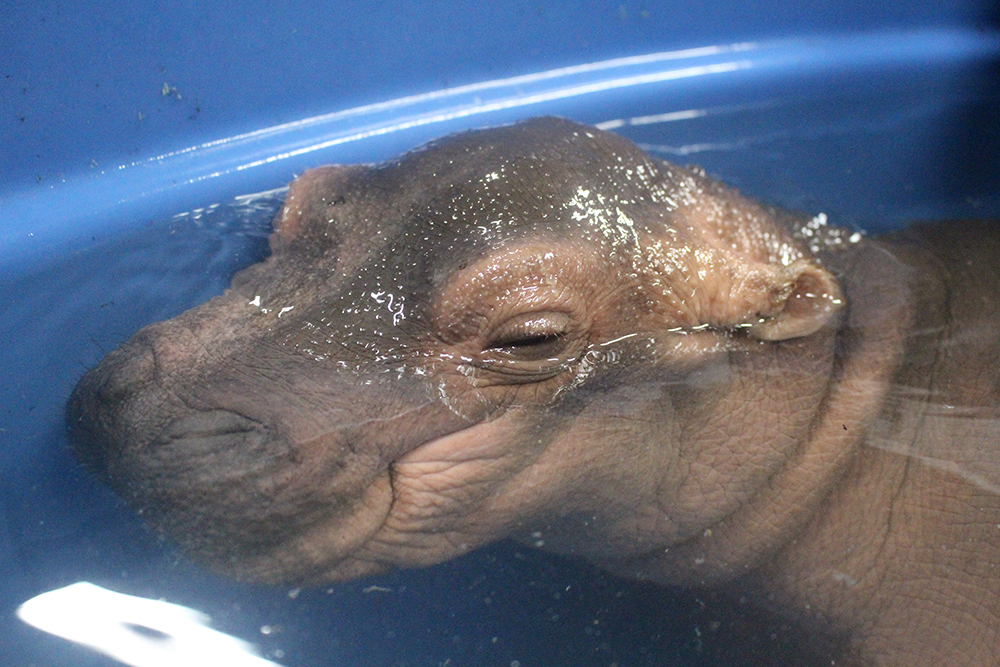Hippo Blog #5: Breathing a Sigh of Relief
 With another week down and another hurdle overcome, we are pleased to share with all of you that Fiona is no longer on supplemental oxygen! Along with her steady weight gains and increased strength and stamina, her little lungs finally seem to have caught up developmentally as well and towards the end of last week, Fiona was taken off the oxygen (hopefully) permanently. The care team could not be more thrilled to have another health hurdle behind us, but even this part of Fiona’s journey is a story worth telling.
With another week down and another hurdle overcome, we are pleased to share with all of you that Fiona is no longer on supplemental oxygen! Along with her steady weight gains and increased strength and stamina, her little lungs finally seem to have caught up developmentally as well and towards the end of last week, Fiona was taken off the oxygen (hopefully) permanently. The care team could not be more thrilled to have another health hurdle behind us, but even this part of Fiona’s journey is a story worth telling.

As many of you will likely remember from previous posts, Fiona started receiving supplemental oxygen at just eight days old. Respiratory problems are quite common among preemies as the lungs are some of the last organs to fully develop during pregnancy in the mammalian body. For a semiaquatic mammal who spends at least 2/3 of its life in water, underdeveloped lungs are an even bigger problem.
Hippopotamus babies often enter the world via a water birth and must therefore begin holding their breath from the very moment they are born. Additionally, because the mother hippopotamus spends so much time in the water, the baby hippo is tasked with nursing underwater as well. Almost immediately after birth, the baby hippo must learn to hold its breath, dive underneath of its mother, nurse, and then come back up to the surface for air. Infant hippos can only hold their breath for roughly 30 seconds at a time, so they must repeat the dive, suckle, resurface cycle numerous times per nursing session just to receive the milk they need to survive and grow. It seems a lot to ask of a newborn, but fortunately for the hippopotamus, the dive response is a natural and already existing instinct that the baby must simply follow to survive.
For Fiona, however, this usually vital instinct proved to be highly dangerous to her overall health. Early on, she would exhibit dive responses while resting and sleeping, and the were often terrifying for the care staff to observe. Fiona would close her nostrils (and often her eyes as well) and simply hold her breath for seconds and seconds on end. During this time we could actually see the color draining from her face, the pink skin around her eyes and mouth turning white as the tissue became hypoxic. Keeper staff would try to interrupt the dive responses by calling her name or lifting her body or head, but our efforts rarely seemed to make a difference. The episodes all ended the same way: Fiona’s little nostrils would finally burst open for exhalation and her eyes would open and roll into focus as if to say “what happened?!”. At 1 week old, these episodes would sometimes last for up to 75 seconds, more than double the 30 second breath-holding limit observed in healthy, full-term infant hippos.
Even more troubling was the physical impact these episodes had on our weak and premature baby. Her underdeveloped lungs struggled to rid her body of the excess CO2 that would accumulate during the dive responses. The resulting build up of carbon dioxide in her blood increased its acidity, causing respiratory acidosis. If left untreated, Fiona’s overly acidic blood could cause irreversible cell damage, affecting her nervous system and resulting in coma or even death.

As frightening as the problem was, the solution was fairly straightforward and simple: oxygen therapy. Our veterinary team decided to put Fiona on supplemental oxygen delivered via a nasal cannula that was to be worn anytime she was napping or resting. Oxygen therapy is a common treatment for respiratory acidosis and in Fiona’s case, the nasal cannula had an additional serendipitous side-effect: no more dive responses! Almost immediately upon introduction of the cannula, the length and frequency of Fiona’s inappropriate breath-holding episodes diminished greatly until they stopped altogether. The care team speculates that the placement of the nasal prong inside Fiona’s nostril actually prevented her from creating a proper seal and initiating the dive response. The end result was that Fiona’s blood pH crept back into the normal range and after weeks without an inappropriate dive response, her preemie lungs were able to catch up on their development. Vet staff continued to monitor the oxygen and carbon dioxide levels in Fiona’s blood as she was successfully weaned off of the oxygen therapy late last week.
Now that Fiona’s lungs are better developed and her strength and stamina have improved, she has been learning to hold her breath in a much more appropriate setting: in the pool! During pool time, Fiona exhibits perfectly normal dive responses that are initiated by dipping her face below the water and typically only last around 15 – 20 seconds at this time. As she grows and spends more time in the water, she will eventually work her way up to holding her breath underwater for around 2 – 3 minutes at a time, like other juvenile hippos, and when she becomes an adult, she will be able to stay submerged for up to 5 minutes at a time, just like mom and dad!
During the next steps of Fiona’s care, she will gradually be introduced to larger and deeper pools that will safely allow her to fine-tune her underwater respiratory control. As always, we will continue to keep you posted on her forward progress and we thank you all so very much for the continued love and support you’ve shown to Fiona and her care team. #TeamFiona!




